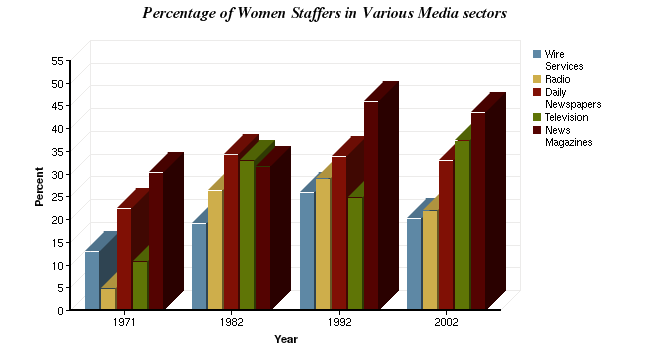The typical U.S. journalist is a 41-year-old white male with more than a decade of experience who works in a newsroom with about 50 colleagues and earns $44,000 a year.
If that seems like an unremarkable composite, that’s because it represents a demographically stagnating media workplace that is aging noticeably and diversifying at a snail’s pace. Those are the findings of the new edition of “The American Journalist,” the major academic research study of the characteristics of American newsrooms, published every ten years since the 1970s.
“If you looked at another industry that hasn’t grown much since the 1970s…you might find similar kinds of demographic patterns,” says professor David Weaver, co-author of “The American Journalist in the 21st Century: U.S. News People at the Dawn of a New Millennium.” At the spine of the newest edition of the book is a telephone survey of 1,149 journalists that probes questions Weaver and his co-authors have been following since 1971, 1982-83, 1992 and for the latest survey 2002.
“That’s just not where the growth is,” he adds. “Mainstream journalism is just not very prosperous now. Sad, but true.”
There are several caveats with the new book. For one thing, it takes a four-year-old snapshot of the profession. And although there is a separate smaller survey of online journalists, the main sample narrowly defines journalists as people working for English language general interest media outlets that include daily and weekly papers, news magazines, radio and TV stations, and news services.
Still, because the 2002 survey can be measured against similar data from three earlier decades and because the sample size is so large, The American Journalist in the 21st Century provides valuable insight into the composition of the media universe and partcularly how it has changed.
One of the most striking findings is the graying of the newsroom. In 1982, more than half of the journalists were under 35 years of age, and only about one in five were older than 45. In 1992, only 41% were still under 35, and still only 22% were older than 45. But by 2002, only 34% were under 35 and more than one out of three (38%) were 45 and up. From 1992 to 2002, the median age of journalists increased from 36 to 41.

Weaver attributes this phenomenon to the “big bulge of baby boomers” hired in the 60s and 70s who are still working in the profession. “A lot of news organizations are pretty pyramidal in structure,” he says. “And I think a lot of young people are impatient.”
While the workplace ages, it remains a bastion of white male dominance with few inroads made by women and minorities. Even though more than half the journalists hired between 1998 and 2002 were women, they only account for 33 % of the media workforce, a number that has not really budged since 1982. (This comes at a time when women make up 47 % of the country’s civilian workforce.)
The survey points out that women don’t tend to stay in the profession as long as men and make up only 24% of those journalists with 20 or more years of experience. In 2002, the media sector with the highest proportion of women staffers was the news magazine industry (44%) while women were scarcest in the wire services (20%).

And at a time when minorities comprised almost a third of the population, the percentage of racial and ethnic minorities in journalism was only 9.5% in 2002, a minimal increase over the 8.2% figure in 1992. The percentage of African-American journalists, at 3.7%, remained unchanged from 1992 while the percentage of Hispanic journalists inched up from 2.2% to 3.3%. Minorities were mostly widely represented in television (15%) and at the daily newspaper (10%).
(The small sample of 100 online journalists revealed no major demographic differences from the larger survey sample, although they tended to be a bit younger and less likely to be a minority.)
“The American Journalist in the 21st Century,” which is authored by Weaver, Randal A. Beam, Bonnie J. Brownlee, Paul S. Voakes, and G. Cleveland Wilhot, also reveals something else about newsrooms. They’re shrinking. The authors estimate there were 116,148 full-time journalists in the mainstream media in 2002, a drop of about 6,000 from 1992. Daily newspapers took a hit of about 8,500 workers in the decade-long span while radio lost about 4,000 employees and television gained about 2,500 employees.
In assessing those numbers, Weaver voices concern about “the shrinking size of the news force.” And he raises a question that was at the heart of our annual “State of the News Media” report this year.
“I’m worried about the economic base of journalism in this country and who is going to support all this reporting,” he says.




